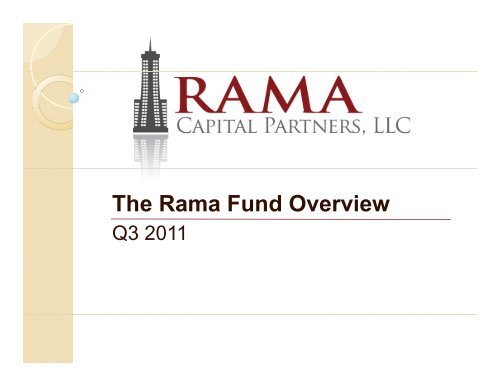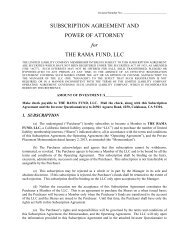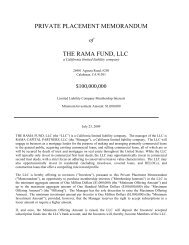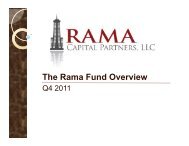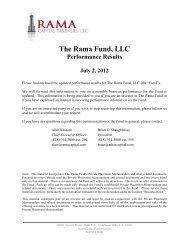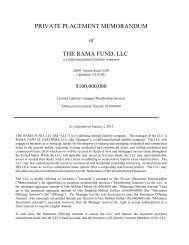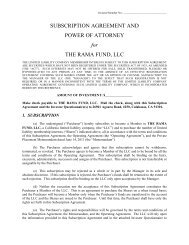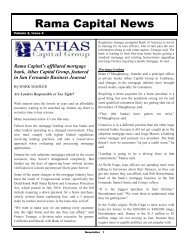The Rama Fund Overview - Rama Capital Partners, LLC
The Rama Fund Overview - Rama Capital Partners, LLC
The Rama Fund Overview - Rama Capital Partners, LLC
You also want an ePaper? Increase the reach of your titles
YUMPU automatically turns print PDFs into web optimized ePapers that Google loves.
<strong>The</strong> <strong>Rama</strong> <strong>Fund</strong> <strong>Overview</strong>Q3 2011
Disclosures• <strong>The</strong> content of this presentation is strictly confidential, is intended solely for the receivingparty and may not be published without the expressed written consent of <strong>Rama</strong> <strong>Capital</strong><strong>Partners</strong>, <strong>LLC</strong> (“<strong>Rama</strong>”) (<strong>Rama</strong>).<strong>The</strong>se materials do not constitute an offer or solicitation by<strong>Rama</strong> for the purchase or sale of interests in <strong>The</strong> <strong>Rama</strong> <strong>Fund</strong>, <strong>LLC</strong> (the “<strong>Fund</strong>”). Anysuch offer or solicitation may only be made by means of the delivery of the applicableconfidential Private Placement Memorandum and other documents associated with theinvestment, each of which should be reviewed in its entirety prior to investment.• <strong>The</strong> information presented herein is intendedtobeasummaryonlyandissubjecttorevision, completion, and changes in operational and investment strategies. <strong>Rama</strong>makes no representation as to the accuracy of the information presented herein. Thispresentation may contain targeted returns and forward looking statements. Investors arecautioned not to place undue reliance on such returns and statements, as actual returnsand results could differ materially due to various risk and uncertainties. In consideringany transactional history or prior performance information contained herein, investorsshould bear in mind that transactional history or prior performance is not necessarilyindicative of future results and there can be no assurances that the <strong>Fund</strong> will achievecomparable results or be able to avoid losses. <strong>The</strong> <strong>Rama</strong> <strong>Fund</strong> construct should providelow volatility, although all investments in the <strong>Fund</strong> may be volatile and an investor couldlose substantially all of his or her investment. Accordingly, such an investment should beundertaken only by investors capable of evaluating and bearing such risk. <strong>The</strong>re is nopublic or secondary market for the interests in the <strong>Fund</strong>, nor is one expected to develop.
Executive SummaryProven track record• 10.19% (1) average annualized net return• 36 month track record, fully audited• Experienced management team• Invest in commercial and residential 1 st trustdeeds/mortgages nationwide(1) Prior performance is not necessarily indicative of future results.3
Investment <strong>Overview</strong>Secured, fixed income investment platform• <strong>The</strong> <strong>Rama</strong> <strong>Fund</strong>, <strong>LLC</strong> (the “<strong>Fund</strong>”) offers the benefits of trustdeed/mortgage investing without the barriers to entry traditionallyinherent in this asset class, including real estate experience andpersonal time commitment.• <strong>The</strong> <strong>Fund</strong> combines low volatility, preservation of capital, andinvestment transparency while offering attractive returns traditionallyassociated with higher risk investments.• Investors can elect to receive monthly cash distributions ib ti or havetheir earnings automatically reinvested in <strong>Fund</strong>.4
<strong>Fund</strong> ObjectivePreservation of capital is our primary objective• <strong>The</strong> <strong>Fund</strong> seeks to finance high yielding loans through equity basedlending, targeting borrowers underserved by traditional lendersbecause of time to close, property type, or credit history.• <strong>The</strong> <strong>Fund</strong> is a California Limited Liability Company that allowsinvestors to pool their financial investments through the acquisitionof membership interests.es s• <strong>The</strong> <strong>Fund</strong>’s pooled resources are loaned to real estate owners andsecured by deeds of trust/mortgages encumbering the underlyingreal estate.• <strong>The</strong> <strong>Fund</strong> invests in first trust deeds/mortgages and requiressubstantial equity cushion to protect the capital invested. <strong>The</strong>maximum loan-to-value l (“LTV”) will not exceed 65%.5
Market OpportunityOpportune time for private mortgage lending• Conventional banks & other lending sources remain under fiscal andregulatory pressure – limited credit availability.• Less competition and regulation – traditional bridge/hard moneylenders are localized and unstructured; very few institutionalbridge/hard money mortgage funds exist.• Default risk is manageable – higher implied default rates aremanageable due to significant protective equity, property cash flowsand adherence to stringent underwriting parameters.• Deep market availability of premium loans allows <strong>Fund</strong> Manager tobe selective.6
Prototypical BorrowersCreative financing solutions address market demand• Self employed borrowers who own, or are purchasing, assets withsignificant equity but do not show sufficient income on their taxreturns to qualify for conventional financing.• Borrowers who need immediate access to capital. We can processloan requests in weeks; banks take several months.• Borrowers who do not have perfect credit histories but who havesubstantial equity in real property.• Borrowers who have pristine credit histories but who are purchasingdistressed assets that need to be stabilized.7
Portfolio MetricsConservative investment parameters• All 1 st liens• Every loan is full recourse• Weighted Average Statistics44.0% LTV (loan-to-value)632 FICO35 months duration8
Portfolio DiversificationComposition by property type9
Portfolio Diversification cont’dComposition by geography10
Historical Returns(1)33.80% cumulative net return since inception• 10.19% average annualized net return• 0.81% average monthly net return• 0.04% monthly net standard deviation• Fully audited<strong>The</strong> <strong>Rama</strong> <strong>Fund</strong>'s Historical Results, NET of FeesJan Feb Mar Q1 Apr May Jun Q2 Jul Aug Sep Q3 Oct Nov Dec Q4 Year2011 0.80 0.70 0.82 2.34 0.76 0.79 0.79 2.36 0.80 0.79 0.81 2.42 7.292010A 0.85 0.69 0.79 2.35 0.80 0.79 0.76 2.37 0.81 0.83 0.81 2.47 0.84 0.81 0.83 2.51 10.0502009A 0.88 0.80 0.89 2.59 0.81 0.83 0.81 2.48 0.86 0.86 0.80 2.54 0.89 0.83 0.82 2.57 10.572008A 0.80 0.78 0.88 2.48 10.31(1) Prior performance is not necessarily indicative of future results.11
Historical Returns(1) cont’dPositive net returns for 36 consecutive monthsMonth hly Net Returns0.900.80070 0.700.600.500.400.300.200.10000 0.00Oct-08Dec-08Feb-09Apr-09Jun-09Aug-09Oct-09Dec-09Feb-10Apr-10Jun-10Aug-10Oct-10Dec-10Feb-11Apr-11Jun-11Aug-11Monthly Net Returns Cumulative Net Returns35.0030.0025.0020.0015.0010.005.00000 0.00Cumulative Net Return(1) Prior performance is not necessarily indicative of future results.12
Relative Returns(1)Stellar returns, uncorrelated, low volatility10.00YTD Comparative Returns8.006.004.00% Ret turns2.000.00-2.00Jan-11Feb-11Mar-11Apr-11May-11Jun-11Jul-11Aug-11Sep-11-4.00-6.00-8.00-10.00<strong>The</strong> <strong>Rama</strong> <strong>Fund</strong> (Net of Fees)Credit Suisse High Yield Index (Junk Bonds)S&P 500 (Equities)Credit Suisse Leveraged Loans Index (Bank Debt)(1) Prior performance is not necessarily indicative of future results.13
Relative Returns(1) cont’dStellar returns, uncorrelated, low volatility<strong>The</strong><strong>Rama</strong><strong>Fund</strong> (1)S&P500(Equities)CS HY(JunkBonds)CS LL(BankDebt)Average Annual Return (%) 10.19 1.23 12.54 6.77Average Month (%) 0.81 0.29 1.09 0.61Monthly Standard Deviation (%) 0.04 6.13 4.38 3.64Highest Month (%) 0.89 9.57 10.08 8.01Lowest Month (%) 0.69 -16.80 -15.84 -13.03Cumulative Return (%) 33.80 3.73 42.55 21.71Positive Months 36 22 28 29Negative Months 0 14 8 7(1) Prior performance is not necessarily indicative of future results.14
<strong>Fund</strong> StructureOperates under a California Finance Lender’s License• Management Fee: 1.0% annualized rate based on AUM,paid monthly• Investors Preferred Return: 9.0% annualized rate,distributed monthly• Performance Fee: 50.0% of excess annualized returnabove 9.0%, paid monthly• 24 month rolling lock-up with 90 days redemption notice15
Management TeamAlim KassamMr. Kassam is the Chief Executive Officer of <strong>Rama</strong> <strong>Capital</strong> <strong>Partners</strong>, <strong>LLC</strong> and the President of Athas<strong>Capital</strong> Group, Inc., both companies that he co-founded with Mr. O’Shaughnessy. Mr. Kassam beganhis career as an Investment Banker with Lehman Brothers, Inc. where he worked with private equityfirms to source and finance leveraged acquisitions and to develop strategic alternatives for their existingportfolio companies. He also worked with global industrial companies across a broad range of corporatefinance projects including mergers and acquisitions, all tranches of debt offerings/underwriting (bankloan, high yield, and mezzanine), and both public and private equity offerings.Mr. Kassam then joined <strong>Capital</strong>Source Finance, <strong>LLC</strong> where he focused on making secured debt andmezzanine investments in healthcare companies. After <strong>Capital</strong>Source, Mr. Kassam joined Pacificor<strong>LLC</strong>, where he wasthe Senior Credit Analyst focusing on stressed, distressed d and special situationsticredit opportunities. Over his tenure, Pacificor’s returns outperformed the high yield indices by over10% per year and the firm’s assets under management grew to $600 million from $200 million.Mr. Kassam then joined Quality Home Loans, the nation’s largest equity based residential mortgagelender, as its CEO one week after the company filed for Chapter 11 protection. In addition to managingthe day-to-day operations of the company, Mr. Kassam was responsible for navigating the bankruptcyprocess and architected a $167M securitization.Mr. Kassam serves on the Advisory Boards of LoanMLS, Inc. and iVision Mobile Inc. He graduatedcum laude from the University of California, Los Angeles with a B.A. in Business Economics and aminor in Accounting.16
Management Team cont’dBrian O’ShaughnessyMr. O’Shaughnessy is the President of <strong>Rama</strong> <strong>Capital</strong> <strong>Partners</strong>, <strong>LLC</strong> and the Chief Executive Officer ofAthas <strong>Capital</strong> Group, Inc., both companies that he co-founded with Mr. Kassam. Mr. O’Shaughnessyhad his start in the mortgage banking industry with Title West Mortgage, Inc. in 1980 where he andquickly excelled to become President. During his tenure, he helped Title West grow from 20 employeesto a company with over 250 employees and $160 million per month in production. Mr. O’Shaughnessyis also credited with building a wholesale division and pioneering subprime loans with Bank One in thedays before credit scores were even established.In 1998, Mr. O’Shaughnessy established his own company, Bankers Express Mortgage, with the visionof running a smaller subprime shop that put profit above production numbers. For 9 years, the entirespan of its existence, it Bankers Express Mortgage never had aquarter in which h it did not post aprofit.In June 2007, Mr. O’Shaughnessy sold his company to Quality Home Loans, his largest competitor,and joined the combined entity as its President. Unfortunately, two months after QHL acquired BankersExpress, the global credit crunch forced the securitization market to shut down and with no viable exitsfor its inventory of loans, QHL was forced to file for bankruptcy protection.Subsequently, Mr. O’Shaughnessy was involved in the sale of the combined company to Michael Klein,a successful entrepreneur and the manager of Pacificor, <strong>LLC</strong>, a $600M hedge fund. After the changeof guard, Mr. O’Shaughnessy helped QHL successfully securitize a pool of $167 million of mortgages.Mr. O’Shaughnessy serves on the Advisory Board of LoanMLS, Inc.17
Management Team cont’dJay GangwalMr. Gangwal has served as an external member of the <strong>Fund</strong>’s loan committee since its inception in 2008.Currently, Mr. Gangwal is a Principal of IRA Realty <strong>Capital</strong> where his primary responsibility is overseeingthe company’s value-add and opportunistic/distressed real estate strategy, which includes sourcingequity, debt and acquisitions. Over the past 10 years, Mr. Gangwal has purchased or financed over $1billion of commercial real estate throughout the United States.He was most recently a Director at Douglas Wilson Companies responsible for the acquisition of valueaddedand distressed real estate properties throughout the Western United States for the firm’s portfolio.Mr. Gangwal has extensive experience in income analysis, equity and loan structures, due diligencereview, cash flow projections, and asset valuations. He has a unique and comprehensive knowledge ofreal estate through his experiences as a lender, advisor, and principal. Before joining DWC, Mr.Gangwal was a Principal with the Chesapeake Equity <strong>Fund</strong> at Legg Mason Real Estate Investors wherehe was responsible for joint venture equity placements and principal investments. During his tenure, Mr.Gangwal acquired over $200 million of commercial real estate projects throughout the United States.Prior to LMREI, he was a Vice President at CW<strong>Capital</strong> <strong>LLC</strong> where he was directly responsible fororiginating senior and mezzanine bridge loans including the origination of over $350 million in mezzanineand debt investments for commercial real estate projects. While at GE, Mr. Gangwal worked on a teamthat structured nearly $600 million of senior and mezzanine debt to be held on GE’s balance sheet. Hereceived his undergraduate degree in Finance and MIS from the California State University, Northridge.Mr. Gangwal is an active member of NAIOP and ULI.18
Case StudyWe help people when others won’tLoan Metrics• Loan-to-value-ratio: 8.54%• Guarantor’s FICO: 761• Loan Amount: $540,000 • Full recourse/personal guarantee: Yes• Value of Collateral: $6,323,000 • Guarantor’s net worth: $10.9M• Lien position: 1 st Lien • Note rate: 11.99%• Other debt: $0• Term of loan: 24 monthsExecutive SummaryOur borrower, XYZ Company, has owned this building since 1993 and built the property using its ownfunds. XYZ Company wanted a very low leveraged loan so that it could inject some working capital intoits business. <strong>The</strong> collateral is a pristine office building on 10 acres with another sister lot - also 10 acres- next door that is fully entitled and ready for development.<strong>The</strong> Borrower / NarrativeXYZ Company is in the print management and document delivery software business. Up until May 2006,its primary business operations were the development, sale and support of a legacy software applicationthat supported high volume printing. At the same time, the company was investing in a new R&Dsoftware development project as changing technology was making the legacy software less competitivein the market and there were declining i sales.In May 2006, XYZ Company sold 60% of its legacy business to a joint venture partner who wasresponsible for revamping the legacy application while XYZ Company shifted all of its focus to the newR&D software project. In November 2009, the new R&D project was completed. <strong>The</strong> elimination of thesoftware developers and the administrative staff in accounting, human resources and informationservices significantly reduced the operating costs of the company. Furthermore, the joint venture partnerhas proven successful in revamping the legacy software application, which XYZ Company still owns 40%of.19
Case Study cont’dStringent underwriting distinguishes us from our peersWhy Conventional Financing Was Not an OptionXYZ Company reported a negative Adjusted Gross Income (“AGI”) (AGI)on its 2008 and 2009 taxes in theamounts of (1,730,462) and (2,035,322), respectively. Also, 100% of our loan proceeds were used ascash-out. In today’s environment, banks prefer to finance purchase transactions or refinancetransactions.How We “Won” the DealWe believe we were selected to procure financing for XYZ Company for the following reasons:• We are willing to fund transactions where the use of proceeds is a cash-out.• Unlike traditional banks, we do not look primarily at the borrower’s Debt to Income (“DTI”) ratio, butrather we focus on the property’s Debt Service Coverage (“DSCR”) ratio. Because of this, we wereable to get comfortable with this transaction even though the borrower had negative AGI.• Beyond the property’s DSCR, we carefully scrutinize a property’s value and one of our principalunderwriting metrics is the Loan-to-Value (LTV) ratio which is a measure of the equity cushionprotecting our invested capital.• We were able to move quickly and processed this transaction from the execution of our LOI to closingin about one month.Exit Strategy for our Bridge LoanOur loan proceeds were used by XYZ Company to fund the marketing and development expensesrelated to their new software application. <strong>The</strong>ir new product has received a strong reception in themarketplace and the company’s financial projections forecast profitability within 24 months of our loanfunding.<strong>The</strong> company expects to be able to repay our loan through the cash flows it derives from itsoperations. Additional potential avenues for the exit of our loan are (1) a refinance via conventionalsources once the company has demonstrated a positive financial trend, or (2) a sale of part or all the ofthe subject property.20


